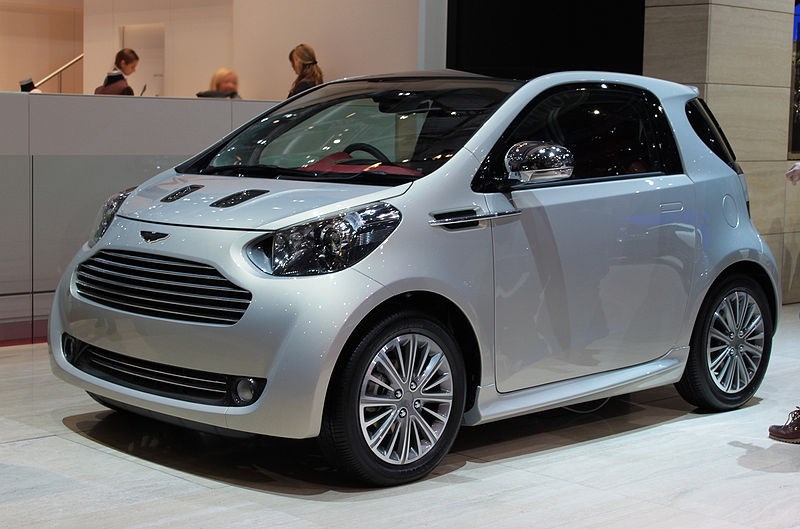In the children’s book, the Ugly Duckling turns out to grow into a beautiful swan. Seemingly without a hint of irony, Aston Martin has been selling a rebranded version of the
Toyota iQ as the Cygnet (the term for a baby swan) for the past few years.
Let’s just say the corporate beak looks a little out of place on a city runabout. I suppose the Bond connection would work if it folded up into a suitcase, but it sadly does not.
Aston Martin’s justification for the car was that it could be used in the same way a luxury yacht has smaller craft which it dispatches while in harbour — call it an automotive dinghy. Drive one’s DB9 on the weekend but pop down to the shops in a nicely appointed tinker toy that’s easier to park than a bicycle.
In reality, the Cygnet’s extremely low emissions also allowed the supercar maker to balance out its whacking great V-12s, bringing the company’s average fuel consumption and carbon dioxide emissions down by being, literally, the weakest link. A bit of a cynical move, but there you go.
Then they had the cheek to charge $50,000 for the thing, but again, it actually seemed to sell well for a while, and even Stirling Moss bought one. Happily, improvements throughout the range now mean that Aston doesn’t need the pint-sized outlier to dodge average-consumption restrictions. The 97 horsepower Cygnet has squawked its last.
Land rover under over-demand
With an entirely revamped lineup, Land Rover has been making headlines for huge weight reduction, greatly improved fuel consumption and even greater desirability. The old “best four by four by far” tagline is starting to look like it actually might apply to the brand, which is experiencing record-breaking sales.
Unfortunately, the Range Rover and Land Rover lines are so popular that the factory isn’t even close to keeping up with demand. Currently, the full-sized Range Rover is sitting at an average six-month wait worldwide and the newly launched Sport has a waiting list stretching out over nine months. You wait that long for a Royal Baby these days.
It’s a great problem to have, in theory, as being in-demand shows that both the engineering and the marketing teams are doing their jobs. However, with rumoured SUVs coming from Bentley and the new small Evoque-fighting Porsche Macan crossover on the way, Land Rover’s production lag could end up costing them sales.
Jig in japan
In a historic decision, the U.S. Department of Justice has handed out more than US$740 million in fines to nine Japanese parts suppliers as part of a huge price-fixing scandal.
Big names like Mitsubishi Electric and Hitachi were accused of colluding to keep the pricing of parts sold to U.S. companies artificially inflated — this includes selling to U.S.-based Toyota plants. Not only does the practice of price-fixing hurt auto manufacturers’ bottom lines and create unfair competition, it also ensures that costs are passed along to the consumer — at the end of the chain, you and I are the ones who end up paying for all this.
Something like 25 million parts ranging from power window switches to electric fans were sold at overinflated prices. Currently, nine companies and two executives have been found guilty and handed extensive fines and jail time.
Major boost for new mini
With the newest Mini Cooper set to debut in a month (spy shots have already been snapped of test cars out on the roads in shakedown trials), some details have leaked out about what’s going to be powering the retro-cute machine.
While a turbocharged four-cylinder returns to motivate Cooper S models — now with 189 horsepower — the real news is with the base engine. Replacing the peppy little naturally aspirated 1.5-litre four cylinder is a new turbocharged three-cylinder engine boasting a modest 135 h.p., but a very decent 162 foot-pounds of torque. Mini’s overboost function allows quick on-ramp blasts of up to 170 foot-pounds, which is about as much as the sporty Abarth version of the Fiat 500, probably the closest competitor.
One fewer cylinder and one more turbocharger makes good sense from an engineering standpoint, but given what they charge for these fashionable city cars, one has to wonder whether or not the type of powertrain once seen in a Pontiac Firefly is really going to be fitting in a luxury accessory. We shall see.
Micra returning to Canada?
This is just a rumour, so don’t get too excited, but industry insiders are reporting there’s a chance that the all-new Nissan Micra could make its way to Canadian shores, even though it’s not bound for the U.S. The Micra has a bit of a cult following here as a no-frill machine that returned decent fuel economy and was the epitome of cheap and cheerful. A friend of mine had one in university with the two-speed automatic, and it was a bit like driving a ride-on lawnmower where instead of “Rabbit” and “Tortoise” settings, you simply had two Tortoise speeds, one a bit noisier.
Still, it had character and only needed refuelling seemingly three times a year. The new car has a 97 h.p. 1.2-litre supercharged three-cylinder, which should be plenty miserly, but perhaps a little bit less miserable. Here’s hoping.
brakingnews@gmail.com



